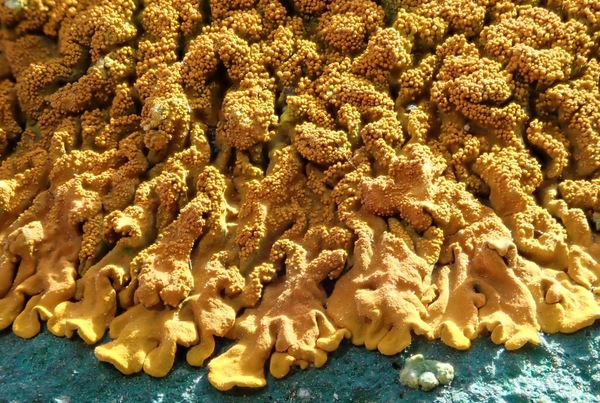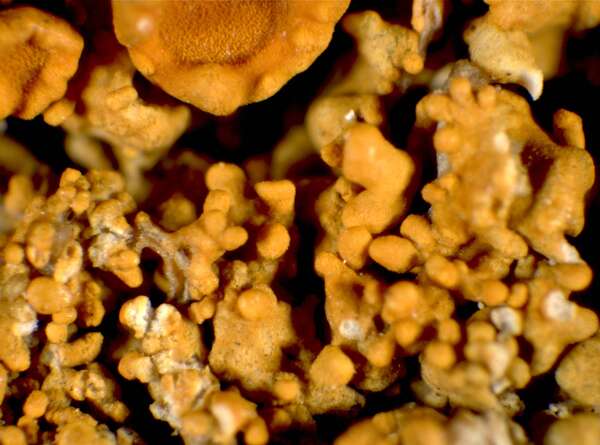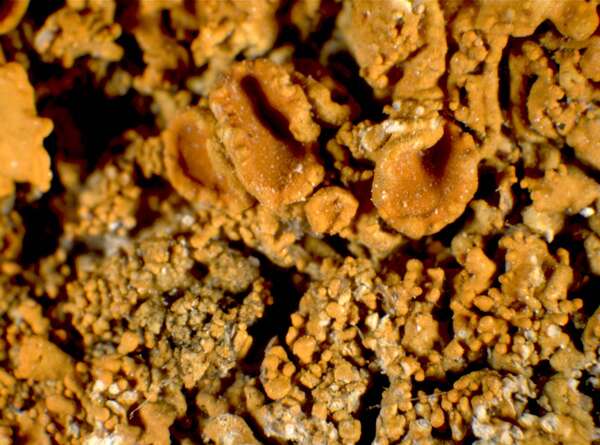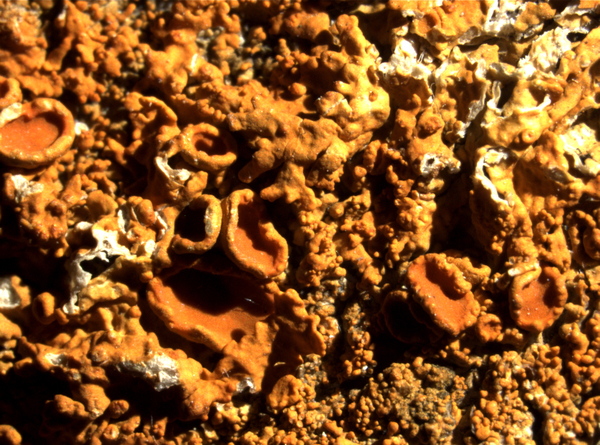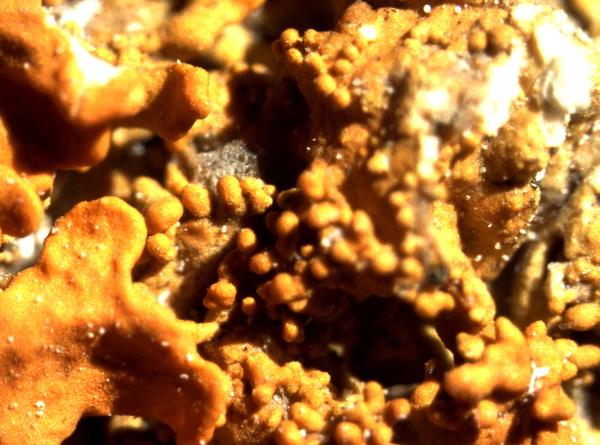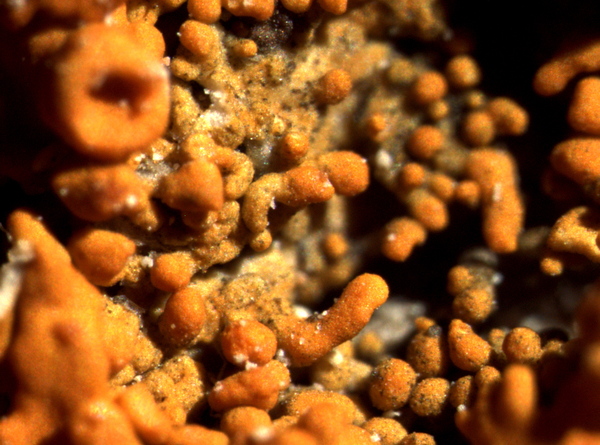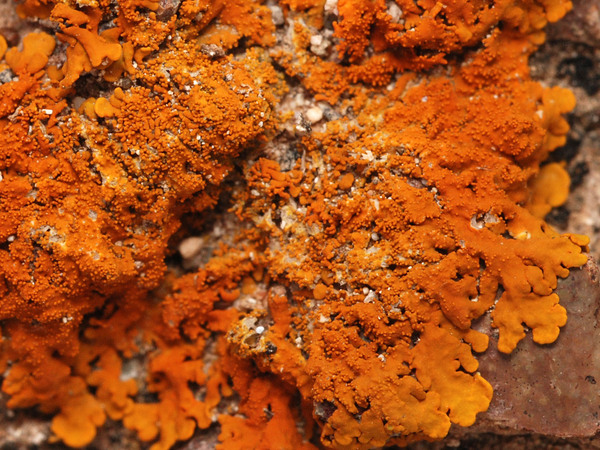Xanthoria mediterranea Giralt, Nimis & Poelt
J. Hattori Bot. Lab., 74: 275, 1993.
Synonyms: Physcia parietina var. isidioidea Beltr.?; Xanthoria isidioidea (Beltr.) Szatala?
Distribution: N - Frl (TSB 21653), Lig (Giordani & al. 2009). C - Laz (TSB 5359), Abr (Eichenberger 2007), Mol (Garofalo & al. 1999, Nimis & Tretiach 1999, Caporale & al. 2008), Sar (Rizzi & al. 2011). S - Camp (Garofalo & al. 1999, Aprile & al. 2003b, Nimis & Tretiach 2004), Pugl (Garofalo & al. 1999, Nimis & Tretiach 1999, Durini & Medagli 2002), Bas (Nimis & Tretiach 1999), Cal (Puntillo 1996), Si (Nimis & al. 1996b).
Description: Thallus foliose, orange to orange-yellow, rather firmly attached, forming 2-3 cm wide, orbicular rosettes which soon tend to coalesce into irregular, much larger thalli. Lobes 2-3 mm wide, flat, rounded at apex, with first wart-like, then clavate to cylindrical, c. 80-200 µm thick, simple to sparingly branched, terete or slightly flattened isidia; lower surface pale, attached to the rock by irregular, coarse hapters. Upper and lower cortex paraplechtenchymatous, the former 10-20 µm thick, the latter 15-20 µm thick, the cells 4-7 µm in diam.; medulla white, rather lax, most hyphae running parallel to the substrate. Apothecia very rare, lecanorine/zeorine, up to 3 mm across, with a concave, deep orange disc and a usually somewhat paler, smooth to isidiate thalline margin. Epithecium brownish-orange, K+ red, hymenium and hypothecium colourless; paraphyses simple or sparingly branched, septate, swollen at tips. Asci 8-spored, clavate, functionally unitunicate, apically thickened with a broad internal beak, the inner part of apex and external cap I+ blue, Teloschistes-type. Ascospores 2-celled, polarilocular, hyaline, ellipsoid, 12-16 x 6-8 µm, the equatorial thickening (“septum”) 4-5 µm. Pycnidia immersed into dark orange warts. Conidia hyaline, ellipsoid, 2-3 x 1.2-1.8 µm. Photobiont: chlorococcoid. Spot tests: cortex K+ dark red, C-, KC-, P-, UV+ intensely orange-red. Chemistry: thallus and apothecia with unidentified anthraquinones, but most probably with parietin (major), fallacinal, emodin, teloschistin and parietinic acid.Note: a mainly Mediterranean species found on the top of isolated calcareous boulders, often together with X. calcicola, and with a similar ecology, but with a narrower altitudinal range.
Growth form: Foliose, broad lobed
Substrata: rocks
Photobiont: green algae other than Trentepohlia
Reproductive strategy: mainly asexual, by isidia, or isidia-like structures (e.g. schizidia)
Commonnes-rarity: (info)
Alpine belt: absent
Subalpine belt: absent
Oromediterranean belt: absent
Montane belt: absent
Submediterranean belt: extremely rare
Padanian area: absent
Humid submediterranean belt: extremely rare
Humid mediterranean belt: very rare
Dry mediterranean belt: rare
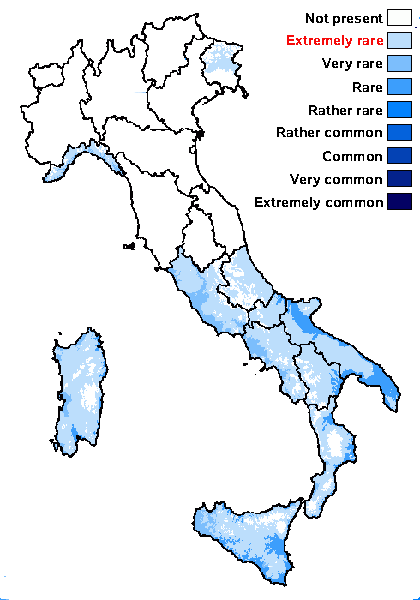
Predictive model
Herbarium samples
Growth form: Foliose, broad lobed
Substrata: rocks
Photobiont: green algae other than Trentepohlia
Reproductive strategy: mainly asexual, by isidia, or isidia-like structures (e.g. schizidia)
Commonnes-rarity: (info)
Alpine belt: absent
Subalpine belt: absent
Oromediterranean belt: absent
Montane belt: absent
Submediterranean belt: extremely rare
Padanian area: absent
Humid submediterranean belt: extremely rare
Humid mediterranean belt: very rare
Dry mediterranean belt: rare

Predictive model
| Herbarium samples |
 Index Fungorum
Index Fungorum
 GBIF
GBIF
